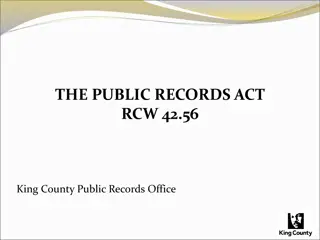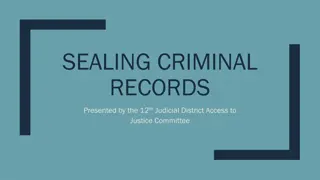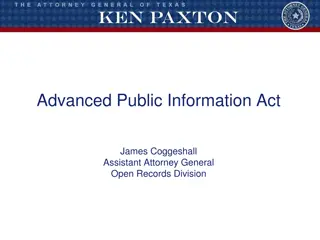Understanding the Importance of Affidavits in Open Records Requests
Agencies must provide affidavits to support why exemptions apply to certain records in open records requests. Failure to submit a sufficient affidavit may result in failing to meet the burden of proof. Learn what an affidavit is, why it is needed, and how to effectively use it to support legal arguments.
Download Presentation

Please find below an Image/Link to download the presentation.
The content on the website is provided AS IS for your information and personal use only. It may not be sold, licensed, or shared on other websites without obtaining consent from the author. Download presentation by click this link. If you encounter any issues during the download, it is possible that the publisher has removed the file from their server.
E N D
Presentation Transcript
The Office of Open Records webinar will begin soon Use the Conversation box to submit questions Submitted questions are records under the RTKL After the webinar ends: Email openrecords@pa.gov or call 717-346-9903 OOR website has resources for agencies & requesters https://www.openrecords.pa.gov/
Erik Arneson, Executive Director AOROs: Preparing Affidavits for Appeals AOROs: Preparing Affidavits for Appeals March 14, 2019 March 14, 2019 Nathanael Byerly, Deputy Director Nathanael Byerly, Deputy Director https://openrecords.pa.gov @ErikOpenRecords @OpenRecordsPA openrecords@pa.gov (717) 346-9903
Introduction Introduction Topics Why is an affidavit needed What is an affidavit Writing an affidavit Terms AO = Appeals Officer FD = Final Determination AORO = Agency Open Records Officer Affidavits = attestations, statement of facts Purpose Improve Efficiency Assist AOROs
Why is an affidavit needed Why is an affidavit needed The burden is on the agency to show that the exemption asserted applies. See 65 P.S. 67.708(a). Affidavits are how an agency details and supports why an exemption applies to a certain record. It is evidence. Testimonial affidavits found to be relevant and credible may provide sufficient evidence in support of a claimed exemption. Heavens v. Pa. Dep t of Envtl. Prot., 65 A.3d 1069, 1073 (Pa.Cmwlth 2013).
Why is an affidavit needed Why is an affidavit needed If the agency fails to file a sufficient affidavit (evidence) in support of its legal argument, it will likely fail to meet the burden. Practice Tip: When an agency files an argument with the OOR alleging that a record is exempt or does not exist, it should always be supported by an affidavit. The same standard applies to third party direct interest participants. It is good practice to tell third parties that they will also need to file an affidavit in support of any legal argument.
What is an affidavit What is an affidavit An affidavit is a factual statement made under oath or penalty of perjury. It claims that a fact or set of facts is true to the best of the affiant s knowledge. It is a factual statement, not a legal argument. Legal conclusions, arguments, and affiant opinions should be made in the letter brief, not the affidavit. The affidavit supports the legal arguments; it should not make the legal arguments. EXAMPLE: Factual statement: The records requested contain employee social security numbers. Legal argument/conclusion: The records are exempt under 708(b)(6) because they contain personal information.
What is an affidavit: Fact vs. Conclusion What is an affidavit: Fact vs. Conclusion It is a factual statement not a conclusion - conclusory. Factual: The requested email was deleted on April 7, 2018 as part of the County s record retention policy. Conclusory: The requested email does not exist. Factual: The requested document contains the social security number of John Doe. Conclusory: The record is exempt under 708(b)(6).
Writing an affidavit: Pre Writing an affidavit: Pre- -Drafting Drafting Put yourself in the place of the AO. The AO probably does not know: the facts or history of your case acronyms your agency uses what your agency calls or names records/files the contents of the records the agency filing and backup system the agency s retention schedule/policy unique nature of documents The AO only needs to know what is applicable to the case. For example, the AO doesn t need to know irrelevant details surrounding the records or the relationship between the agency and requester Tell a story Be a Guide
Writing an affidavit: Structure Writing an affidavit: Structure Include the caption and docket number of the case at the top. Example: Smith v. Home County, OOR Dkt. AP 2019-5678 Indicate that the affidavit is one of these three: pursuant to 18 Pa.C.S. 4904 (option used on OOR forms) made under penalty of perjury made under oath and notarized Arrange the facts in a coherent manner. State each fact in a separate paragraph. Number the paragraphs so that the affidavit is easier to read and refer to in the FD. Reference any supporting documents by marking them as exhibits. Use a reference or index where necessary. Numbered pages Dates Bate Stamp
Writing an affidavit: The affiant Writing an affidavit: The affiant The affidavit should include the name and title of the person giving the testimony. Why is it important that this person is telling the AO this? Why does this person know what the affidavit says is true? How or why does this person know about the records at issue? Why would they know where the records are or what they contain? What would they know about the facts or situation(s) surrounding the record or request?
Writing an affidavit: Drafting Writing an affidavit: Drafting An affidavit should establish a nexus between the exemption and any withheld records or redactions. It should answer these general questions: Who What Where When How Why
Writing an affidavit: Examples Writing an affidavit: Examples Example: Records do not exist or are not in the possession* of agency. Questions should at least include: Who looked for the records Where did the AORO or affiant look for the records Why did they look there What records did the AORO or affiant look at during search Who would know if a record was never created When was the search conducted What keywords were used as part of the search Where else would the records be another agency Were all copies destroyed/deleted When Why By whom What is agency retention policy
Writing an affidavit: Examples Writing an affidavit: Examples Moore v. Department of Corrections Moore v. Department of Corrections, 2017 Pa. Commw. Unpub. LEXIS 704, 177 A.3d 1073 Request was for records that DOC claimed did not exist DOC provided affidavit to OOR that stated that: no responsive records exist within the Department s custody, possession or control the AORO reviewed [Moore s] request and researched it Court held that this was conclusory and generic More details are needed and at a minimum should include a description of the records the AORO reviewed
Writing an affidavit: Examples Writing an affidavit: Examples The AORO Guidebook Exhibits 16 18 are updated OOR samples: https://www.openrecords.pa.gov/RTKL/AgencyGuides.cfm Look at the exemption and ask what facts would help determine if the exemption may apply. Example: Release of video would threaten public safety and endanger safety of the building Not enough to just say it s a risk or it s a threat to security Questions should at least include: What is in the record that makes it a threat or risk Why/How would release threaten safety or security Can info be redacted Who is attesting that threat or risk exists Experience Expertise Knowledge of situation
Writing an affidavit: Examples Writing an affidavit: Examples Gregg Twp. v. Grove Gregg Twp. v. Grove, 2018 Pa.Commw.Unpub. LEXIS 343; 2018 WL 3097074 Request was for footage from security cameras in building used for municipal offices Agency denied claiming release would threaten public safety and endanger safety of the building 708(b)(2) and (3) Court held agency did not meet burden and video was public Why? Affidavit was silent as to what was depicted in the video Affidavit referred generally to all of the cameras but failed to explain why footage from one camera will jeopardize safety Affidavit did not explain how the cameras are used to enhance public safety monitored some contemporaneously Affidavit did not address whether information could be redacted Affidavit had conclusory statements without explaining details about how security will be jeopardized
Writing an Affidavit: Editing Writing an Affidavit: Editing Re-read and edit your affidavit. Proofread for both accuracy and grammar. Example: The records requested are not within the Agency s possession, custody, or control. The records requested are within the Agency s possession, custody, or control. One word can make a big difference. Eliminate language that makes the affidavit contradictory.
Follow Follow- -up from the AO up from the AO Respond to AO requests for more information. Do not take it personally Do not take it as an attack on your credibility More detail may be needed More explanation of process, terms, or content may be required A stated fact is better than making an inference of fact
Court cases and OOR Final Determinations Court cases and OOR Final Determinations Look for situations or facts similar to yours. What exemption was cited What records were requested Why did the court or the OOR say the affidavit did or did not support the agency s argument
Brown v. DOC Brown v. DOC, 2017 Pa. Commw. Unpub. LEXIS 653, 177 A.3d 1066 DOC denied a request for records due to outstanding fees Court said that DOC failed to show the requester owed outstanding fees Affidavit stated: Records were copied and prepared for Requester Requester had not paid He had an outstanding balance Affidavit should have also identified the documents that were copied as well as the number of pages included in the charge
List of court cases List of court cases Affidavits must be detailed, nonconclusory, and submitted in good faith. Office of the Governor v. Scolforo, 65 A.3d 1095, 1103- 1104, 2013 Pa. Commw. LEXIS 120, *20-22, 2013 WL 1729755; The affidavit must (1) include detailed information describing the nature of the records sought and (2) connect the nature of the various records to the reasonable likelihood that they can be properly withheld under an exemption. Carey v. Pa. Dep't of Corr., 61 A.3d 367, 375-376, 2013 Pa. Commw. LEXIS 30, *16-19, 2013 WL 257149; Harrisburg Area Cmty. College v. Office of Open Records, 2011 Pa. Commw. Unpub. LEXIS 378, *19, 2011 WL 10858088; It s not sufficient to recite a list of subjects that records might include, which would cause them to fall under a certain exception. The affidavit must describe how the records reflect information that is protected by the exception. Office of the Governor v. Scolforo, 65 A.3d 1095, 1103-1104, 2013 Pa. Commw. LEXIS 120, *20-22, 2013 WL 1729755; When an affidavit discusses a group or category of records, the affiant must explain which of the records in that category are protected and which are not. Carey v. Pa. Dep't of Corr., 61 A.3d 367, 375-376, 2013 Pa. Commw. LEXIS 30, *16-19, 2013 WL 257149; An affidavit must be specific enough to permit the Court [and AO] to evaluate the exemptions as they apply to particular documents.Vista Health Plan, Inc. v. Dep't of Human Servs., 2018 Pa. Commw. Unpub. LEXIS 295, *19, 189 A.3d 41, 2018 WL 2436329;
Webinar Q&A Please send your questions now Use the Conversation box to submit questions Submitted questions are records under the RTKL After the webinar ends: Email openrecords@pa.gov or call 717-346-9903 OOR website has resources for agencies & requesters https://www.openrecords.pa.gov/























